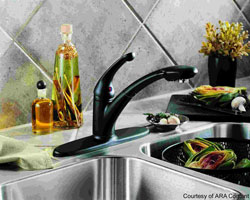 Faucet Care and Maintenance -- What Every Homeowner Should Know Faucet Care and Maintenance -- What Every Homeowner Should Know
(ARA) - Consider the number of times you run your hands under it quickly
while cooking. What about rinsing plates or filling a glass or pot with water?
When the kitchen faucet isn’t working properly, the kitchen doesn’t run
smoothly.
Just as there are secrets for removing red wine from carpet and coffee stains
from ties, there are methods for keeping your faucet in working order.
“A faucet has a lifecycle of its own -- with special considerations in the
early years and others as the faucet gets older. The trick is knowing how to
clean and maintain your faucet throughout its life,” says Barbara Peterson,
senior product manager at Delta and someone who has a knack for solving
not-so-common plumbing problems.
In a new home or when a replacement faucet is used for the first time,
homeowners may notice flecks and particles in the water coming through the
faucet. These are probably remnants of installation materials such as solder and
copper chips, which can potentially cause a blockage and damage the faucet. To
avoid problems, remove the tip of the faucet, known as the aerator, by
unscrewing it, turning the handle(s) to a “full-on” position, and allowing the
water to flush through the system for about two minutes. Then replace the
aerator.
Day-to-day, kitchen faucets require low maintenance. Cleaning is easily done
using a damp cloth and mild soap, then drying with a soft cloth to retain luster
and shine. Window cleaning products also work well, and for crevices, an old
toothbrush can be a handy tool. Remember, you’re not cleaning the hulls of a
Navy ship; avoid harsh cleaners and abrasives that could damage your faucet’s
finish. With any cleaning product, be sure to read and follow recommended usage
instructions.
“For faucets with a matte finish, like Brilliance Pearl Nickel from Delta,
you can use a liquid or aerosol furniture polish to wipe the faucet clean,”
suggests Peterson. “The silicon oil in the polish fills the textures, rendering
a more uniform appearance. This may darken the finish slightly, but will protect
it from fingerprints and help reduce variations.” When it comes to finishes,
homeowners should look for tested protection, like the Brilliance finish from
Delta, which won’t corrode, tarnish or discolor.
* Removing Deposits
The amount of minerals in your water determines whether you have “soft” or
“hard” water. Higher mineral count hard water sometimes causes lime and mineral
deposits on faucets and drains. To remove stains, try a mild abrasive or window
cleaner -- avoid scrubbing with coarse heavy-duty sponges.
For really stubborn deposits, place a cloth soaked in white vinegar over the
deposits for several hours. Vinegar, which is a weak acid, can dissolve many of
these deposits. After removing the cloth, a mild cleaner to wipe the faucet
clean should finish the job.
* Minor Maintenance
Quality faucets from well-known companies should provide long-term
performance with little maintenance. However, there are small measures that can
be taken to keep your faucet functioning well.
Through normal use, and depending on the water conditions in your area, seats
and springs experience wear and may need to be replaced. If you’re waking up to
that drip, drip, drip of your faucet, you may be able to solve the problem at
home, without calling a professional.
“Homeowners should always refer to the materials that came with their
faucet,” advises Peterson. “At Delta, we have some components that are common to
our faucets -- such as a cam, packing, a ball, seats and springs -- and the
location and set-up of these depends on the specific faucet and repairs should
be made accordingly.”
Before beginning work on a faucet, turn off the water supply and cover the
sink drain so parts do not fall into it. Then, following the diagram in the
user’s manual, locate the exposed screw and remove the faucet handle(s) to
reveal the inner-works of the faucet. Inside, there are “seats,” the rubber ring
parts. If they’ve been worn or are dirty, they need to be replaced. This can be
done easily by purchasing replacements from a home improvement store. When
buying replacement parts, make sure to select “genuine parts.” Imitation or
“universal” parts can significantly reduce the performance of the faucet and
void the manufacturer’s warranty.
“Whether it’s a popular pull-out style or two-handled faucet, choosing the
best products from the beginning can help to stave off any repair headaches,”
Peterson says. “Make sure to buy products with a lifetime faucet and finish
limited warranty. Making the best decision at the onset provides a good
foundation for carefree, confident use of your kitchen faucet.”
Delta Faucet Company offers a toll-free hotline directly to experts at (800)
345-DELTA (3358). The company also offers a free “Faucet Care and Maintenance”
brochure via telephone or online at www.deltafaucet.com.
Courtesy of ARA Content Views: 1 | 